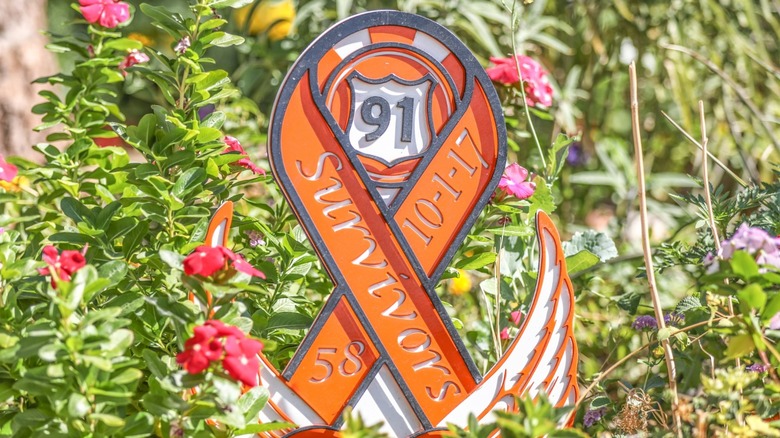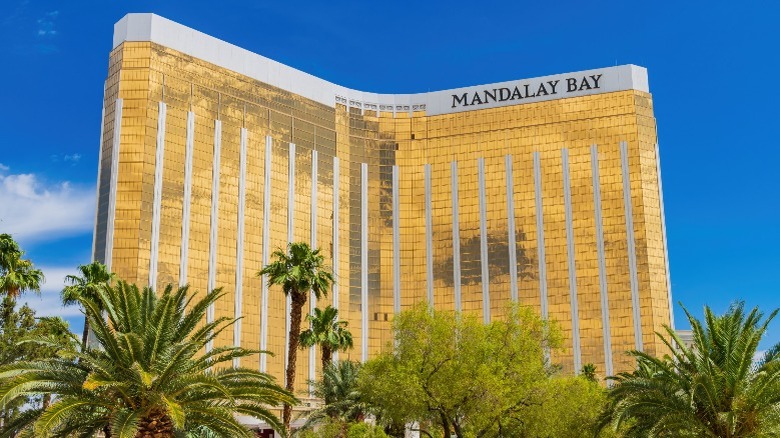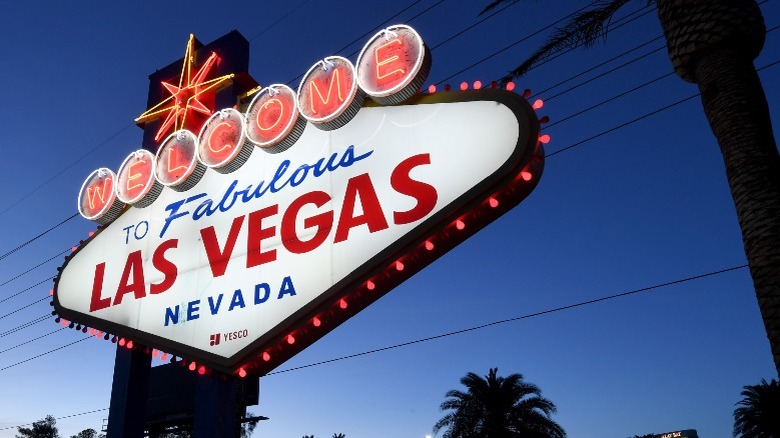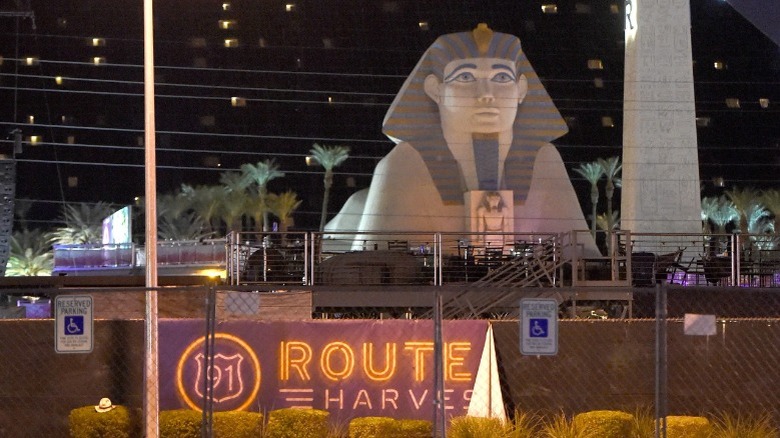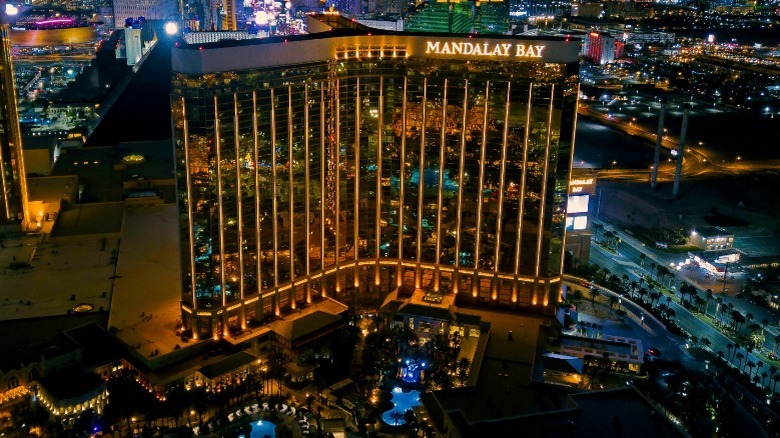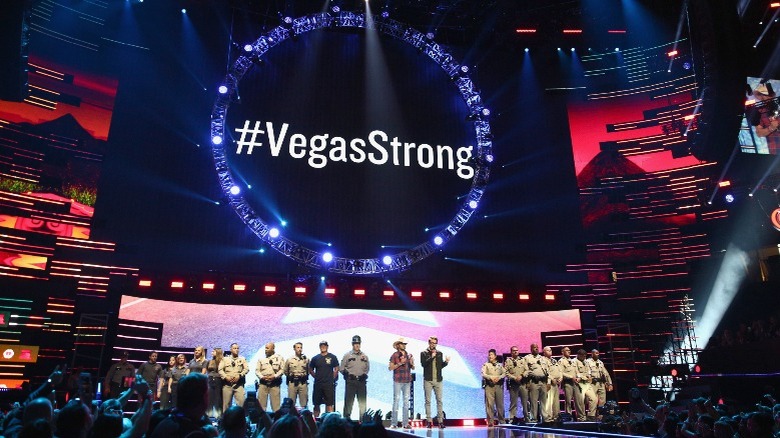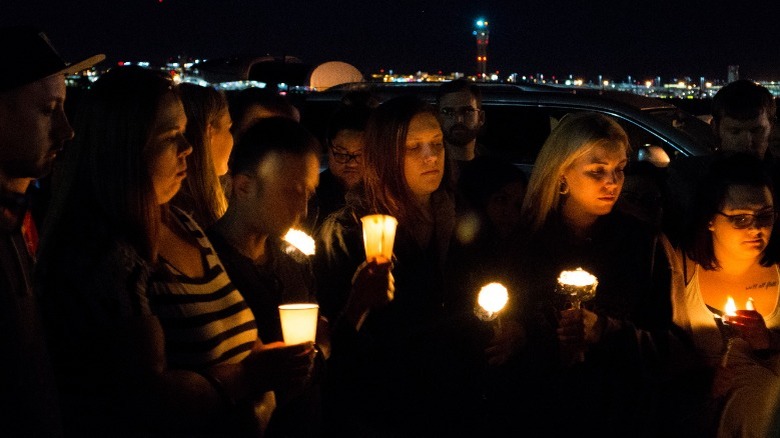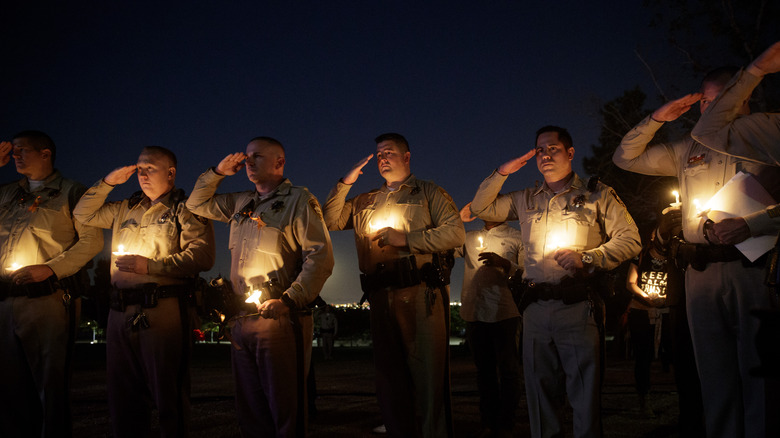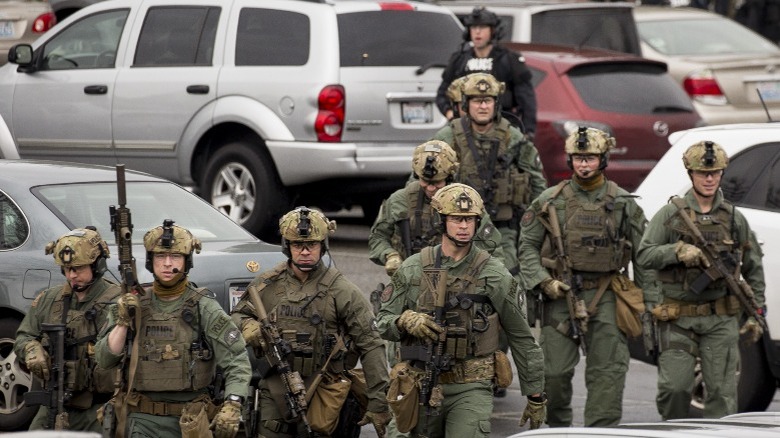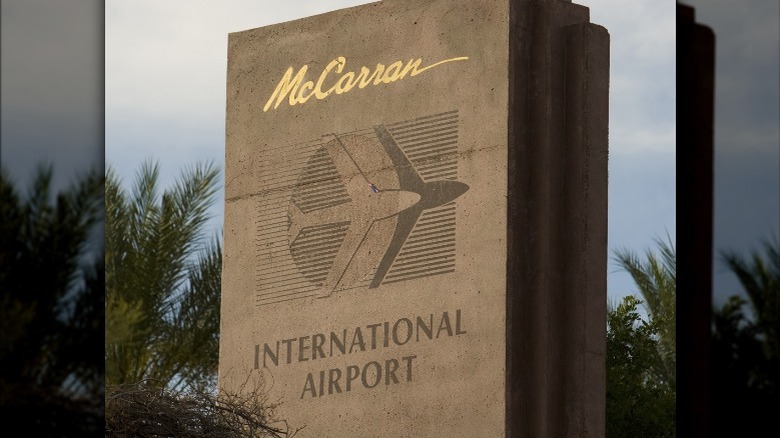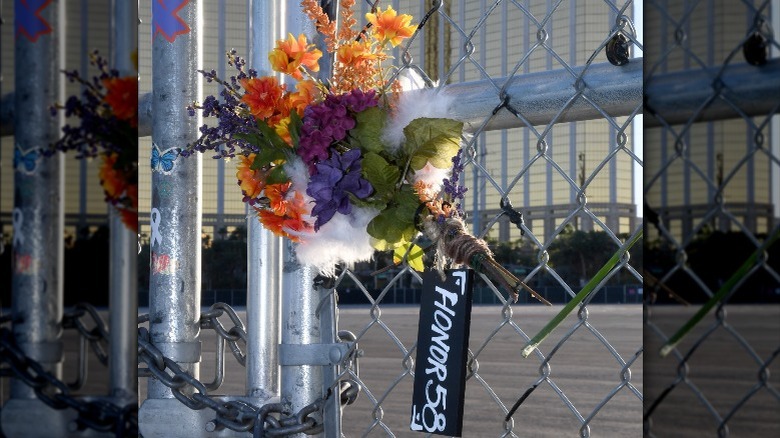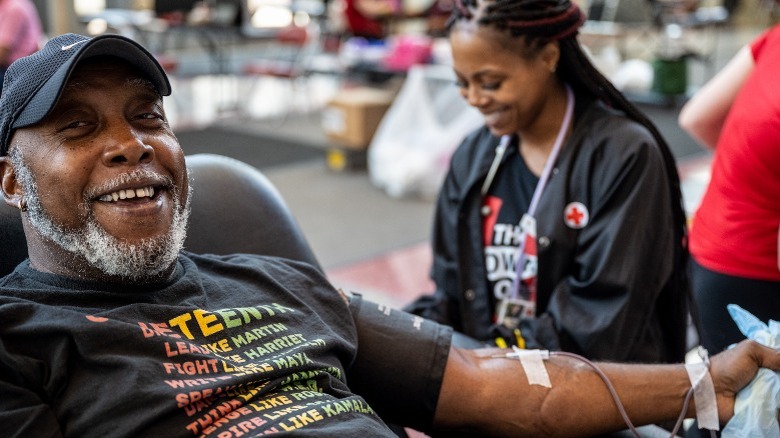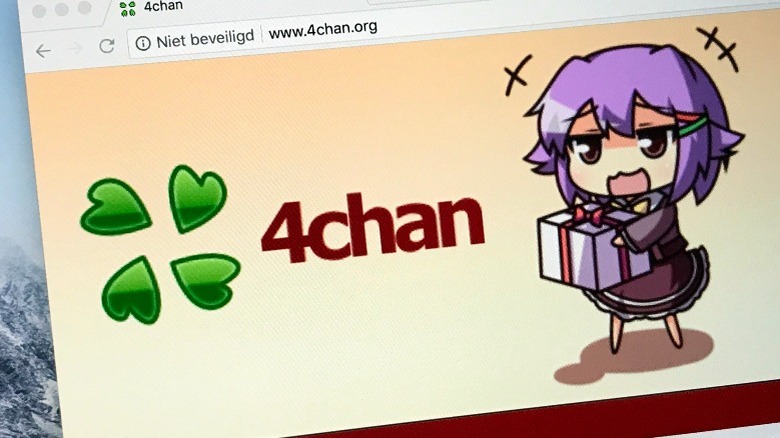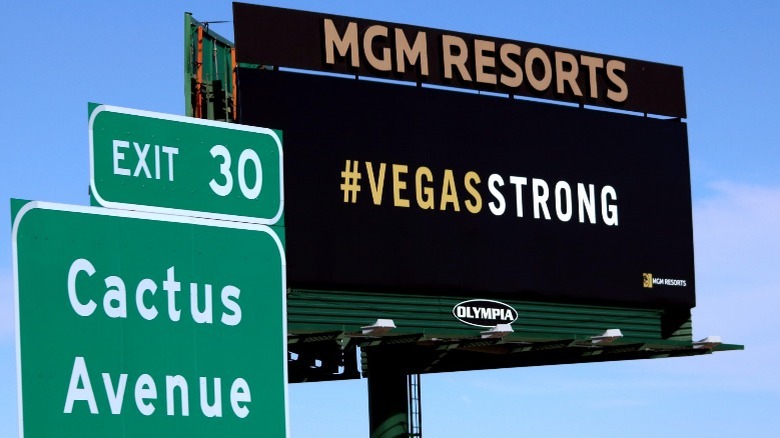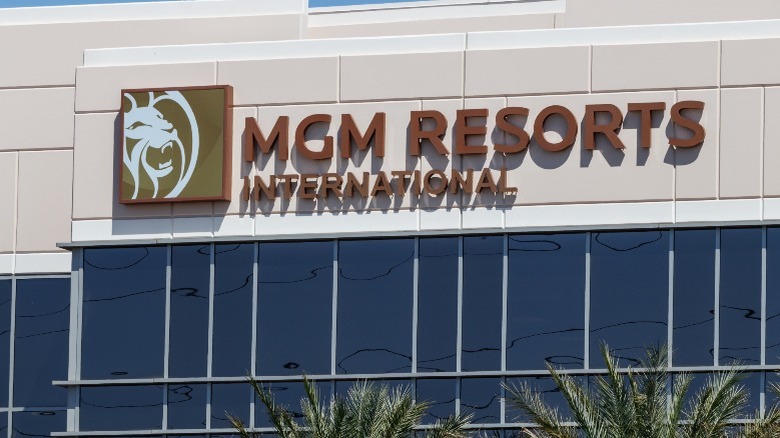The 2017 Las Vegas Shooting Timeline Explained
On October 1, 2017, on what was supposed to be a night of fun, festivities, and celebration in Las Vegas, 64-year-old retired postal worker Stephen Paddock committed mass murder. Seconds before the shooting started, the Route 91 Harvest Country Music Festival was happening at the former Las Vegas Village, and concert goers were dancing and having a good time. Suddenly, Paddock started to open fire on the crowd, shattering the atmosphere and immediately creating mass chaos. Paddock ultimately killed almost 60 people during the shooting, not including himself, and his shots injured more than 800 (per History).
To commit the massacre, Paddock had rented a room at the Mandalay Bay hotel and casino in Las Vegas, which directly overlooked the venue. He rained down terror on the defenseless crowd for nearly 20 minutes, inflicting casualty after casualty, showing no sign of remorse or humanity. The shooting shocked and angered the nation, which was still mourning the 2016 PULSE Nightclub shooting in Orlando, Florida. The country collectively mourned the losses of the Las Vegas dead and hoped it would be the last of these mass shootings, a wish that unfortunately went unfulfilled. This is the 2017 Las Vegas shooting timeline, explained.
Paddock cases Las Vegas a month before the shooting
The Las Vegas Metropolitan Police Department's (LVMPD) preliminary report notes that Stephen Paddock's behavior had started to change over the previous year leading up to the shooting. His girlfriend, Marilou Danley, stated that Paddock had become distant and their relationship had recently lacked intimacy. Paddock constantly reported feeling unwell or in pain, but he did not suffer from any significant or debilitating injuries or illnesses according to his doctor. He also was a high stakes gambler, sometimes betting $10,000 or more at a time. He also had a propensity for guns and rifles, purchasing nearly 84 during his lifetime, 55 of which he bought in the year leading up to the shooting.
According to the preliminary report, Danley said that she and Paddock and had gotten a room at the Mandalay Bay in early September 2017, just a month prior to the mass shooting. They stayed in room 60-235, which would have been a mirror of the same location as the room he committed the shootings from, just 30 floors higher. Danley constantly looked over and saw Paddock staring out the windows from different angles and viewpoints. In hindsight, she realized he was probably planning out how he was going to carry out the shooting a month later.
September 17: Paddock arrives at the Ogden in Las Vegas
Stephen Paddock arrived in Las Vegas again on September 17 and stayed at the high-rise Ogden condominium downtown. According to the LVMPD's official report of the investigation, Paddock had rented three separate rooms at the Ogden, all of them overlooking the "Life is Beautiful" event that was happening just outside its front doors. He made reservations at the Mandalay Bay casino and specifically requested a room ending in 235. That was the same number as the room he had rented in early September with his girlfriend, and thus would have similar angles and viewpoints. On September 25, Paddock checked into the Mandalay Bay in room 32-135 and started bringing up multiple bags of luggage.
Interestingly, Paddock rented and paid for rooms at the Ogden and Mandalay Bay for every night between September 17 and October 1, but nearly every night or early morning he would return to his home in Mesquite and not stay in the rented room. The LVMPD's report shows him constantly shuttling back and forth between Mesquite and Las Vegas, at times gambling for hours and hours on end, and at other times purchasing firearms and transporting them into Mandalay Bay.
September 29: the Route 91 Harvest Festival begins
On September 29, two days before the fateful shooting took place, the Route 91 Harvest Festival began. It happened at the former Las Vegas Village, an open air venue located directly on the strip. The festival was a three-day event and was supposed to have performances by such massive country music acts as Jason Aldean, Big and Rich, Sam Hunt, and Kane Brown (per Las Vegas Review-Journal). On the night of the shooting, Hunt, Aldean, Jake Owen, and Maren Morris were scheduled to perform (per ConcertArchives).
According to People, Aldean had just taken the stage when Stephen Paddock began to open fire. Immediately, everything was thrown into chaos and the band evacuated the venue. In an Instagram post on the third anniversary of the shooting, Aldean shared a picture of the Route 91 memorial and called the incident "probably the worst night of our lives." He said the anniversary would always be painful for him, but that he was thankful to still be alive. His wife, Brittany Aldean, also shared an Instagram post, where she recalled being just two months away from giving birth to her daughter at the time and wrote that the incident changed their lives forever.
The afternoon of October 1: Paddock prepares to begin the massacre
On October 1, 2017, at 2:06 in the morning, Stephen Paddock left him home in Mesquite for the final time. He arrived at Mandalay Bay a few hours later and immediately proceeded to wander around the casino and gamble (via the LVMPD's official report). He brought more suitcases up to his room and had his final meal from the hotel's room service that afternoon. At some point before 10:00 p.m. that night — the report is not clear when exactly — Paddock screwed an L shaped bracket to the only nearby fire escape exit to prevent security from opening it from outside in the stairway.
At 9:18, while Paddock was in his room preparing to attack, Mandalay Bay security officer Jesus Campos was notified of an unrelated alarm coming from a room just down the hall from Paddock's. While Campos was responding to the alarm he tried to enter the hallway through the blocked door and he encountered Paddock's bracket. After walking to the floor above and then taking the elevator back down and walking over, Campos noticed the L shaped bracket on the doorway and immediately notified the security dispatcher of the unusual problem.
Outside, the public was still completely unaware of what was going to happen. It was just another Las Vegas night full of excitement and joy.
10:05 p.m.: the shooting starts
According to the LVMPD's official report, at precisely 10:05 p.m., Stephen Paddock started the mass shooting. He started firing an unknown amount of gunshots into the Las Vegas Village, causing mass chaos and panic. Security officer Jesus Campos heard the gunfire, but he initially thought it sounded like a drill. After investigating, he realized the sounds he was hearing were not drills but gunfire, and he was shot in the calf while running away from the room.
At this point, Campos still did not understand what was going on. He actually told the dispatcher that he had been shot by a BB or pellet gun, and he did not realize the severity of the situation. Jason Aldean had been performing onstage for just over 20 minutes by this point, and officers in the crowd initially mistook the gunfire for fireworks. However, within a few seconds they started to recognize the sound as gunfire and quickly started to react.
10:05-10:16 p.m.: the massacre
According to the LVMPD, in 11 terrifying minutes, Paddock killed 58 people (though that number was later adjusted to 60, per Reuters) and left over 800 injured. He fired hundreds of shots per minute into the crowd of thousands, hitting people all over the venue. Paddock targeted LVMPD police officers in the crowd as well as random civilians, and multiple police officers were hit. He also tried to cause explosions when he fired (and hit) fuel tanks located nearby.
The report states the LVMPD found over 1,050 shell casings in Paddock's room during their investigation that were fired from 14 separate rifles. Paddock used a variety of different types of ammunition, including hollow points, frangible incendiary armor piercing bullets, and armor piercing incendiary ammunition. A total of 24 firearms were recovered from the room, including several AR-10s and AR-15s, many of them with bump stocks and magazines capable of holding 100 rounds a piece. Some of the guns had optics or scopes attached, and at least a few had bipods mounted beneath them.
According to the FBI's official report, Paddock never planned to be caught in the room after the shooting was over. The FBI found no specific motive for the attack, but noted that Paddock had wanted to use the attack to gain notoriety and infamy, and that he "displayed minimal empathy throughout his life."
10:10 p.m.: LVMPD starts to mobilize to find the shooter
At 10:10 p.m., five minutes after Stephen Paddock started the massacre and then shot security officer Jesus Campos, another Mandalay Bay employee unknowingly made his way towards Paddock's room (via the LVMPD report). Engineer Stephen Schuck had been called to remove the L bracket that Campos had reported earlier, and he arrived with tools in hand, completely oblivious to the situation. As soon as Schuck entered the hallway and headed to the exit next to Paddock's room, Paddock immediately started to open fire in his direction. Rounds went whizzing by Schuck's head as he ducked for cover as quickly as he could. He made verbal contact with Campos and radioed back to his dispatcher about the situation.
Meanwhile, LVMPD officers outside had started to mobilize multiple teams into the Mandalay Bay to search for the shooter. Officers quickly narrowed down the shooter's location to the 32nd floor and waited for reinforcements. According to the LVMPD's report, by the time one had made it to the 32nd floor, Paddock had ceased firing. LVMPD and SWAT officers started to evacuate guests and patrons from the wing that Paddock was located in, and Schuck locked the elevators to prevent more unknowing guests from arriving.
11:20 p.m.: Paddock is found dead
Per the LVMPD, at 10:18 p.m. the heat detection indicator in Paddock's room stopped recording any further readings, indicating the shooting had stopped. Within minutes, the LVMPD was on the 32nd floor, and by the end of the hour, SWAT officers had narrowed down Paddock's location to his specific room and broken through his L barricade. The officers noticed a room service cart with wires leading from it to Paddock's room, and they feared he had booby trapped an explosive device to blow them up if they got close. However, after not hearing any activity from the room for nearly an hour, SWAT decided they needed to enter to determine whether or not the shooter was still in the room and alive.
At 11:20, SWAT breached Paddock's room by blowing up the door. CNN released audio footage from the breach, and you can hear the commander giving instructions followed by the sound of the explosion of Paddock's door. Per the LVMPD report, two teams entered Paddock's room and began to search for him. They quickly found him dead on the ground from what they assumed was a "self-inflicted gunshot wound." When they breached the door to the neighboring room, one of the SWAT officers accidentally fired a three-round burst from his gun which caused some commotion, but luckily no one was hurt.
The airport and hotel were shut down for hours
The shooting caused widespread chaos throughout Las Vegas for days. Harry Reid International Airport (McCarran International Airport at the time) was temporarily shut down for all planes because no one knew who the gunman was or what was happening (via the LA Times). Flights were diverted to other airports in Las Vegas further away from the action.
According to the New York Times, the Mandalay Bay also experienced its own lockdown in the shootings aftermath. The day after the shooting, all the exits from the hotel to the Strip were still locked down and there was still a huge police presence inside and outside. A valet claimed that Paddock's car was still in the parking garage, which itself had been completely sealed. Many guests were locked out of their rooms, especially any located on the 32nd floor near Paddock's room, and the lobby was full of guests sleeping and wearing towels and bathrobes given to them by the hotel. Many of the guests were likely still in shock about what they had just lived through, and were still processing the harrowing events of the night before.
Initial reports stated 58 victims had died
The day after the shooting, all of the major newspapers in America devoted their front pages and headlines to its coverage. The New York Times published an article that listed each victim in the attack and included a short biography for each of them. The Times and other newspapers initially reported that 58 people had been killed and hundreds had been injured during the shooting.
According to the Las Vegas Review-Journal, in the three years after the massacre, two more victims died from wounds sustained the day of the shooting. Kimberly Gervais died in 2019 from complications due to spinal injuries she suffered as a result of the shooting, and Samanta Arjune experienced daily pain from being shot in the leg at the time of her death. The LVMPD initially refused to include either Gervais or Arjune on the official list of victims, but in 2020 they finally relented and added them, bringing the official death toll to 60 (not including Paddock) (per the Las Vegas Review-Journal).
The day after the massacre, on October 2, President Donald Trump issued an executive order honoring the victims of the shooting. He ordered all flags be flown at half-staff for the next four days both in the United States and at embassies and facilities abroad.
After the shooting, blood donation lines surged
The New York Times reported that the day after the shooting, loyal Las Vegas residents came out in droves to aid the victims. Some people donated items like water and food, and others gave blankets and different supplies. Many people also donated blood which was desperately needed to cope with the over 800 injuries. Blood donation lines surged out the door at places and people posted pictures of themselves to their social media waiting in line or donating blood. Not just in Las Vegas, but throughout Nevada waiting rooms were full and lines snaked around buildings to accommodate the hundreds of eager donors.
Even though the shooting happened at 10 p.m. the night before, a spokesman for United Blood Services claimed people began showing up at her center as early as 2 a.m. the next morning to donate. Many even stayed it out when they were told they would have to wait five hours until the building opened. In addition, an online fund started by Clark County Commission Chairman Steve Sisolak had reached over $850,000 by 3 p.m. the next day.
Misinformation surged in the days and weeks after the massacre
In the days and weeks after the shooting occurred, social media was rife with misinformation and budding conspiracy theories. The New York Times reported that ISIS remarkably claimed responsibility for the shooting after the event, but most were skeptical of their boasts in light of other incidents they had falsely taken credit for. Later, the Times reported that the message board 4chan had been scheming about ways to promote misinformation and blame the shooting on liberals. Google and Facebook were both susceptible to misinformation and both unknowingly helped amplify it for hours until they could correct it. Google ended up issuing a statement claiming the misinformation was relatively contained, but promised to refine their algorithms in the future to make them better at filtering (per the BBC).
Snopes reported on a conspiracy that involved a second gunman firing from a separate floor in Mandalay Bay. They conclusively debunked the theory by pointing out the flawed reasoning and perversion of evidence among the perpetrators of the conspiracy. However, they noted the widespread reach of the conspiracy that had already taken place and how it spread quickly through social media.
Multiple public tributes were held to honor the victims
Immediately after the shooting, multiple public events in Las Vegas honored the victims of the tragedy. The Las Vegas Rock and Roll Marathon took place just over a month later, and it was full of tributes and memorials (per CNN). The course included a 300-foot wall with #VegasStrong printed on it and in memorial of the victims. A number of runners dedicated their participation in the marathon to loved ones who had died or been injured in the shooting. Many runners wore #VegasStrong t-shirts and other apparel that supported the victims. The marathon, which usually features live music from beginning to end, instead featured "an extended moment of silence" for the first two miles to honor the tragedy.
At their first home game after the shooting, the Las Vegas Golden Knights included multiple tributes (via NHL). They removed all of the ads on the board and replaced them with #VegasStrong images everywhere. They also set up a line for fans to text with donations. In addition, players from both teams wore #VegasStrong stickers on their helmets.
MGM settles with victims for $800 million
While the shooting may have ended 11 minutes after it started, the court battles dragged on for years. The Las Vegas Review-Journal reported that just under two months after the shooting, 450 victims had signed on for a class action lawsuit against the owner of the Mandalay Bay, MGM Resorts International. The lawsuit alleged wrongful death and negligence, and it included victims from 19 different states and Canada. Also mentioned in the lawsuit were Paddock's estate and various groups responsible for organizing and putting on the festival.
In one of the worst PR moves in recent history, MGM Resorts International filed a countersuit against the over 1,000 victims who were suing them (via the New York Times). MGM sought to protect themselves from legal liability in the case by citing an obscure law that they argued characterized them as a "defense company." Social media and lawyers for the victims were furious over the move and immediately called into question its legality and morality.
Finally, almost three years to the day of the shooting, CNN reported that a judge had approved an $800 million dollar settlement between MGM and the victims. The settlement was going to be split between over 4,000 defendants, with individual payout amounts to be determined by a neutral team of judges. MGM itself only reportedly paid out $49 million, with the rest being covered by their liability insurance.
